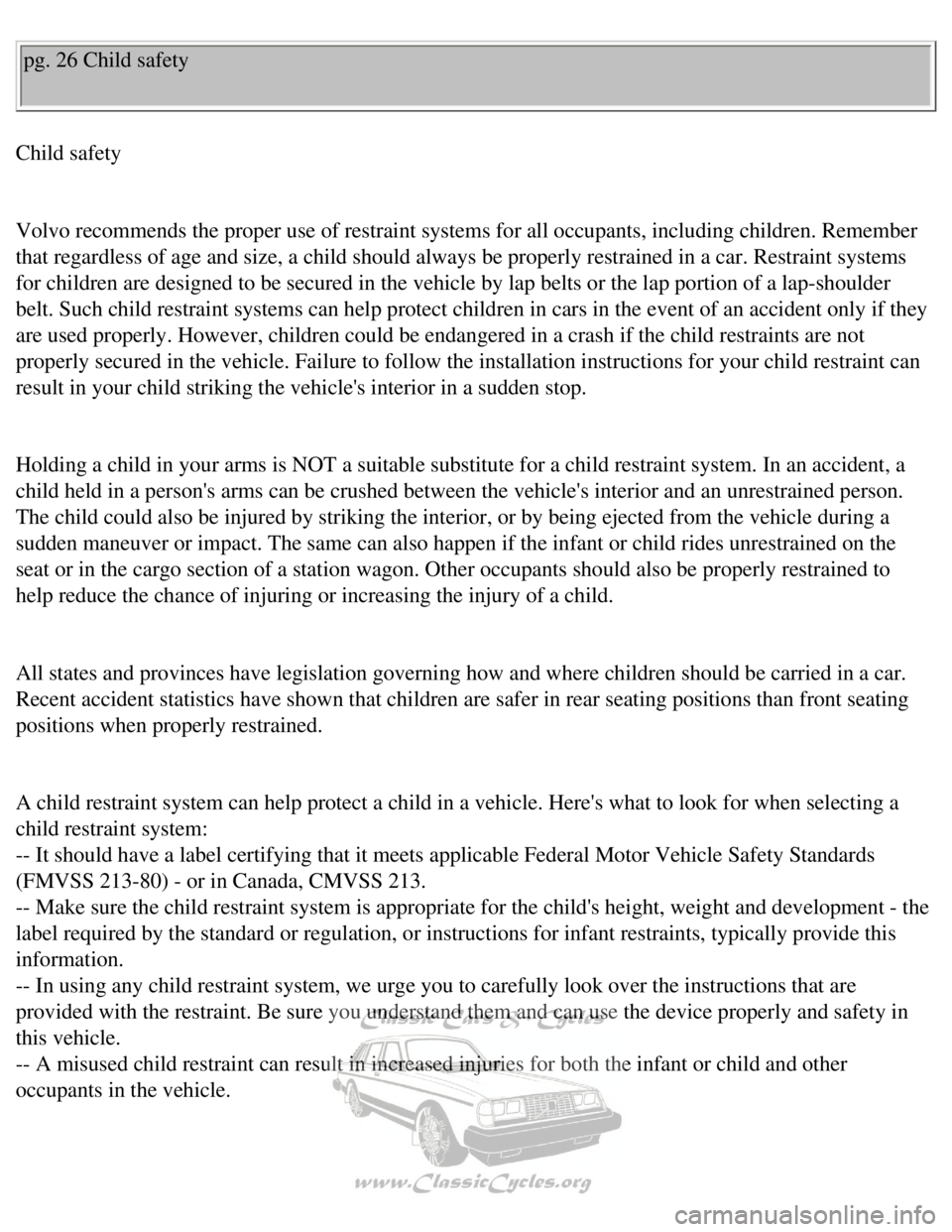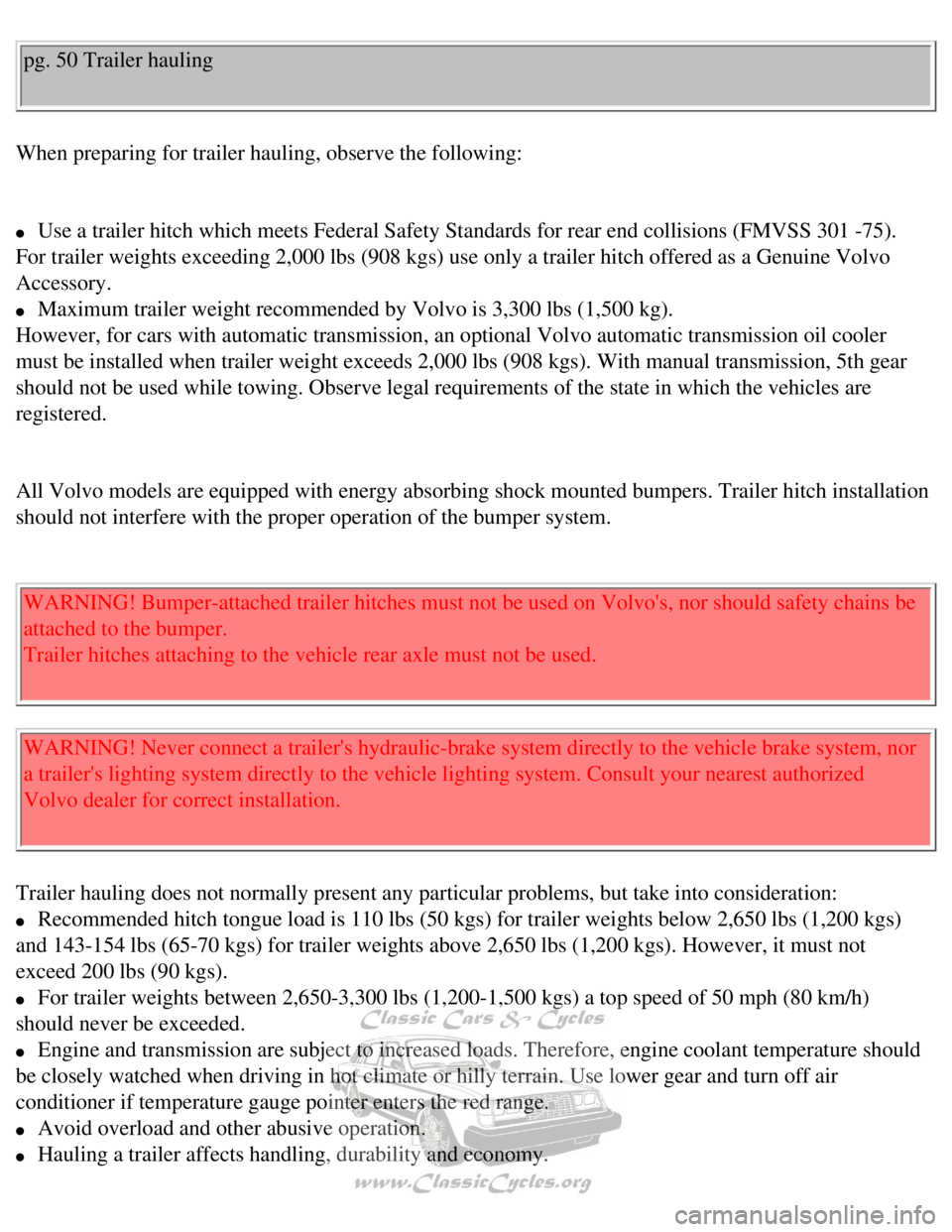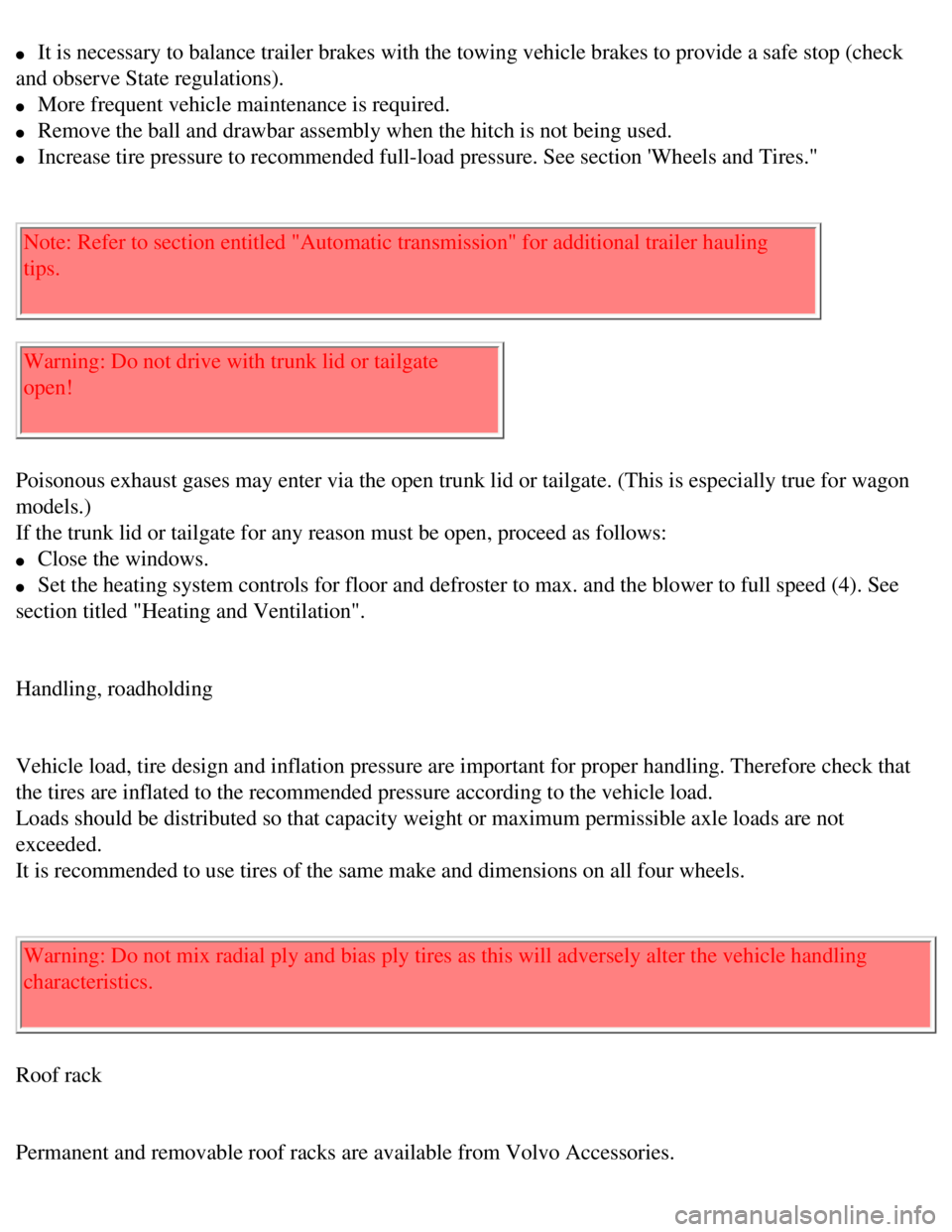1990 VOLVO 240 weight
[x] Cancel search: weightPage 3 of 143

Volvo 1990 240 Model
compartment. For further information regarding these regulations, please\
contact your dealer. pg. 3 Seat belts: "Something We Believe In"
Despite our strongest recommendations, and your best intentions, not wea\
ring a seat belt is like
believing "It'll never happen to me!". Volvo urges you and all adult occ\
upants of your car to wear seat
belts and ensure that children are properly restrained, using an infant,\
car or booster seat determined by
age, weight and height.
Fact: Inevery state and province, some type of child-restraint legislati\
on has been passed. Additionally,
most states and provinces have already made it mandatory for occupants o\
f a car to use seat belts.
So, urging you to "buckle up" is not just our recommendation - legislati\
on in your state or province may
mandate seat belt usage. The few seconds it takes to buckle up may one d\
ay allow you to say, "It's a
good thing I was wearing my seat belt". pg. 4 General Information
Do not export your Volvo to another country before investigating the cou\
ntry's applicable safety and
exhaust emission requirements. In some cases it may be difficult or impo\
ssible to comply with these
requirements. Modifications to the emission control system(s) may rend\
er your Volvo not certifiable for
legal operation in the U.S., Canada or other countries.
Model versions of the basic Volvo Models 240, 240 DL
USA: Canada:
240 4-door, Wagon 240 DL 4-door, Wagon
240 DL 4-door, Wagon pg. 5 Keys
Owner's Key
This key operates all locks in the vehicle
Service Key
Front doors
Starting (ignition)/steering wheel lock
The key number codes are stamped on a separate tag supplied with the key\
s. This tag should be
file:///K|/ownersdocs/1990/1990_240/90240_00.htm (3 of 4)12/30/2006 8:\
25:01 AM
Page 32 of 143

Volvo 1990 240 Model
pg. 26 Child safety
Child safety
Volvo recommends the proper use of restraint systems for all occupants, \
including children. Remember
that regardless of age and size, a child should always be properly restr\
ained in a car. Restraint systems
for children are designed to be secured in the vehicle by lap belts or t\
he lap portion of a lap-shoulder
belt. Such child restraint systems can help protect children in cars in \
the event of an accident only if they
are used properly. However, children could be endangered in a crash if t\
he child restraints are not
properly secured in the vehicle. Failure to follow the installation inst\
ructions for your child restraint can
result in your child striking the vehicle's interior in a sudden stop.
Holding a child in your arms is NOT a suitable substitute for a child re\
straint system. In an accident, a
child held in a person's arms can be crushed between the vehicle's inter\
ior and an unrestrained person.
The child could also be injured by striking the interior, or by being ej\
ected from the vehicle during a
sudden maneuver or impact. The same can also happen if the infant or chi\
ld rides unrestrained on the
seat or in the cargo section of a station wagon. Other occupants should \
also be properly restrained to
help reduce the chance of injuring or increasing the injury of a child. \
All states and provinces have legislation governing how and where childr\
en should be carried in a car.
Recent accident statistics have shown that children are safer in rear se\
ating positions than front seating
positions when properly restrained.
A child restraint system can help protect a child in a vehicle. Here's w\
hat to look for when selecting a
child restraint system:
-- It should have a label certifying that it meets applicable Federal Mo\
tor Vehicle Safety Standards
(FMVSS 213-80) - or in Canada, CMVSS 213.
-- Make sure the child restraint system is appropriate for the child's h\
eight, weight and development - the
label required by the standard or regulation, or instructions for infant\
restraints, typically provide this
information.
-- In using any child restraint system, we urge you to carefully look ov\
er the instructions that are
provided with the restraint. Be sure you understand them and can use the\
device properly and safety in
this vehicle.
-- A misused child restraint can result in increased injuries for both t\
he infant or child and other
occupants in the vehicle.
file:///K|/ownersdocs/1990/1990_240/90240_06.htm (1 of 9)12/30/2006 8:\
25:04 AM
Page 33 of 143

Volvo 1990 240 Model
When a child has outgrown the child safety seat (approximately 4-5 year\
s of age, depending on size) you
should use the rear seat with the standard seat belt fastened. The best \
way to protect the child here is to
place the child on a cushion so that the seat lap belt is as far down on\
the hips as possible.
A specially designed and tested safety cushion for this purpose can be o\
btained from your Volvo dealer.
If necessary, an extra seat is available for use in the luggage compartm\
ent of station wagon models. This
seat is designed for two children, each up to 80 lbs. in weight and up t\
o 53 inches in height. pg. 27 Child safety
Child Restraint Anchorages
Volvo cars are fitted with child restraint top tether anchorages in the \
rear seat.
There are three anchorages under the rear section of the car's rear wind\
ow shelf on sedans and in the
back of the rear seat in wagons. When the car is delivered, the holes fo\
r these anchorages are covered by
plastic screws. In cars designated for Canada, one top tether anchorage \
set will be in the glove box. The
top tether anchorage set includes the top tether anchorage plate, an M8 \
bolt (30 mm long) and a plastic
trim cover. If another set is needed, consult your Volvo dealer.
Installing the top tether
Remove the plastic screw covering the anchorage point you want to use. T\
his can be done with a
suitable coin. The screw is removed counterclockwise.
file:///K|/ownersdocs/1990/1990_240/90240_06.htm (2 of 9)12/30/2006 8:\
25:04 AM
Page 46 of 143

Volvo 1990 240 Model
Max. length of load 6 1/2 ft = 2 m.
Max. weight of load 33 lbs. = 15 kg.
WARNING!
Take care when loading/unloading the vehicle. Always turn off the engine\
and apply the parking
brake. Place automatic transmission gear shift selector in position P (\
Park). This will prevent
accidental movement of the gear shift selector to position D (Drive). \
Contents | Top of Page
file:///K|/ownersdocs/1990/1990_240/90240_07.htm (6 of 6)12/30/2006 8:\
25:04 AM
Page 64 of 143

Volvo 1990 240 Model
pg. 50 Trailer hauling
When preparing for trailer hauling, observe the following:
l Use a trailer hitch which meets Federal Safety Standards for rear end co\
llisions (FMVSS 301 -75).
For trailer weights exceeding 2,000 lbs (908 kgs) use only a trailer h\
itch offered as a Genuine Volvo
Accessory.
l Maximum trailer weight recommended by Volvo is 3,300 lbs (1,500 kg). \
However, for cars with automatic transmission, an optional Volvo automat\
ic transmission oil cooler
must be installed when trailer weight exceeds 2,000 lbs (908 kgs). Wit\
h manual transmission, 5th gear
should not be used while towing. Observe legal requirements of the state\
in which the vehicles are
registered.
All Volvo models are equipped with energy absorbing shock mounted bumper\
s. Trailer hitch installation
should not interfere with the proper operation of the bumper system.
WARNING! Bumper-attached trailer hitches must not be used on Volvo's, no\
r should safety chains be
attached to the bumper.
Trailer hitches attaching to the vehicle rear axle must not be used.
WARNING! Never connect a trailer's hydraulic-brake system directly to th\
e vehicle brake system, nor
a trailer's lighting system directly to the vehicle lighting system. Con\
sult your nearest authorized
Volvo dealer for correct installation.
Trailer hauling does not normally present any particular problems, but t\
ake into consideration:
l Recommended hitch tongue load is 110 lbs (50 kgs) for trailer weights \
below 2,650 lbs (1,200 kgs)
and 143-154 lbs (65-70 kgs) for trailer weights above 2,650 lbs (1,20\
0 kgs). However, it must not
exceed 200 lbs (90 kgs).
l For trailer weights between 2,650-3,300 lbs (1,200-1,500 kgs) a top sp\
eed of 50 mph (80 km/h)
should never be exceeded.
l Engine and transmission are subject to increased loads. Therefore, engin\
e coolant temperature should
be closely watched when driving in hot climate or hilly terrain. Use low\
er gear and turn off air
conditioner if temperature gauge pointer enters the red range.
l Avoid overload and other abusive operation.
l Hauling a trailer affects handling, durability and economy.
file:///K|/ownersdocs/1990/1990_240/90240_11.htm (1 of 6)12/30/2006 8:\
25:06 AM
Page 65 of 143

Volvo 1990 240 Model
l It is necessary to balance trailer brakes with the towing vehicle brakes\
to provide a safe stop (check
and observe State regulations).
l More frequent vehicle maintenance is required.
l Remove the ball and drawbar assembly when the hitch is not being used.
l Increase tire pressure to recommended full-load pressure. See section 'W\
heels and Tires."
Note: Refer to section entitled "Automatic transmission" for additional \
trailer hauling
tips.
Warning: Do not drive with trunk lid or tailgate
open!
Poisonous exhaust gases may enter via the open trunk lid or tailgate. (\
This is especially true for wagon
models.)
If the trunk lid or tailgate for any reason must be open, proceed as fol\
lows:
l Close the windows.
l Set the heating system controls for floor and defroster to max. and the \
blower to full speed (4). See
section titled "Heating and Ventilation".
Handling, roadholding
Vehicle load, tire design and inflation pressure are important for prope\
r handling. Therefore check that
the tires are inflated to the recommended pressure according to the vehi\
cle load.
Loads should be distributed so that capacity weight or maximum permissib\
le axle loads are not
exceeded.
It is recommended to use tires of the same make and dimensions on all fo\
ur wheels.
Warning: Do not mix radial ply and bias ply tires as this will adversely\
alter the vehicle handling
characteristics.
Roof rack
Permanent and removable roof racks are available from Volvo Accessories.\
file:///K|/ownersdocs/1990/1990_240/90240_11.htm (2 of 6)12/30/2006 8:\
25:06 AM
Page 130 of 143

Volvo 1990 240 Model
pg. 97 Specifications
98Dimensions and weights
98Cargo space
99Engine
100Cooling system
100Fuel system
100Ignition system
101Power transmission
101Front suspension
102Capacities
102Electrical system
pg. 98 Specifications
Dimensions and weights Sedan models Wagon models
Length 189.9" (482 cm) 190.7" (484 cm)
Width 67.3" (171 cm) 67.3" (171 cm)
Height, curb weight 56.3" (143 cm) 57.5" (146 cm)
Wheelbase 104.3" (265 cm) 104.3" (265 cm)
Ground clearance (full load) 4.7" (12 cm) 4.7" (12 cm)
Track, front
rear 56.3" (143 cm)
53.5"(136cm) 56.3" (143 cm)
53.5" (136cm)
file:///K|/ownersdocs/1990/1990_240/90240_20.htm (1 of 14)12/30/2006 8\
:25:15 AM
Page 131 of 143

Volvo 1990 240 Model
Turning circle (between curbs) 32.2' (9.8 m) 32.2' (9.8 m)
Curb weight (depending on type) 2934-3009 lbs (1331-1365
kg) 3073-3115 lbs (1394-1413
kg)
Gross vehicle weight (GVW) 4030 lbs (1830 kg) 4300 lbs (1950 kg)
Capacity weight 948 lbs (430 kg) 1080 lbs (490 kg)
Permissible axle weight, front
rear 1885 lbs (855 kg)
2180 lbs (990 kg) 1885 lbs (855 kg)
2600 lbs (1180 kg)
Max. trailer weight (trailer equipped
with service brakes) 3300 lbs (1500 kg)
3300 lbs (1500 kg)
Max. hitch load 200 lbs (90 kg) 200 lbs (90 kg)
Cargo Space Wagon models
Length with rear seat up 44.5" (113 cm)
Length with rear seat down 74.0" (188 cm)
Maximum width 53.1" (135 cm)
Height 32.9" (84 cm)
Volume with rear seat up 41 cu. ft. (1.2 m3)
Volume with rear seat down 76 cu. ft. (2.151
m3)
file:///K|/ownersdocs/1990/1990_240/90240_20.htm (2 of 14)12/30/2006 8\
:25:15 AM